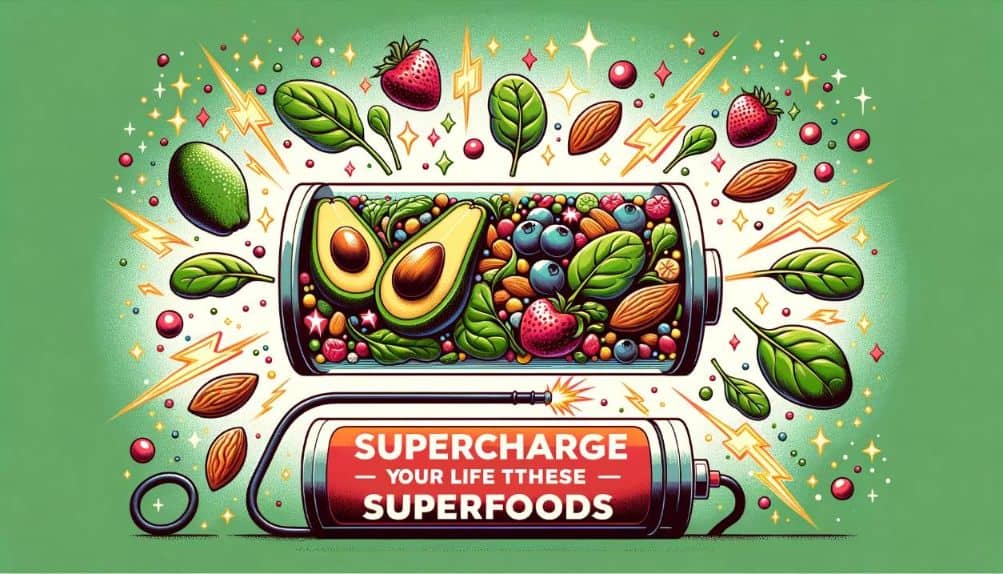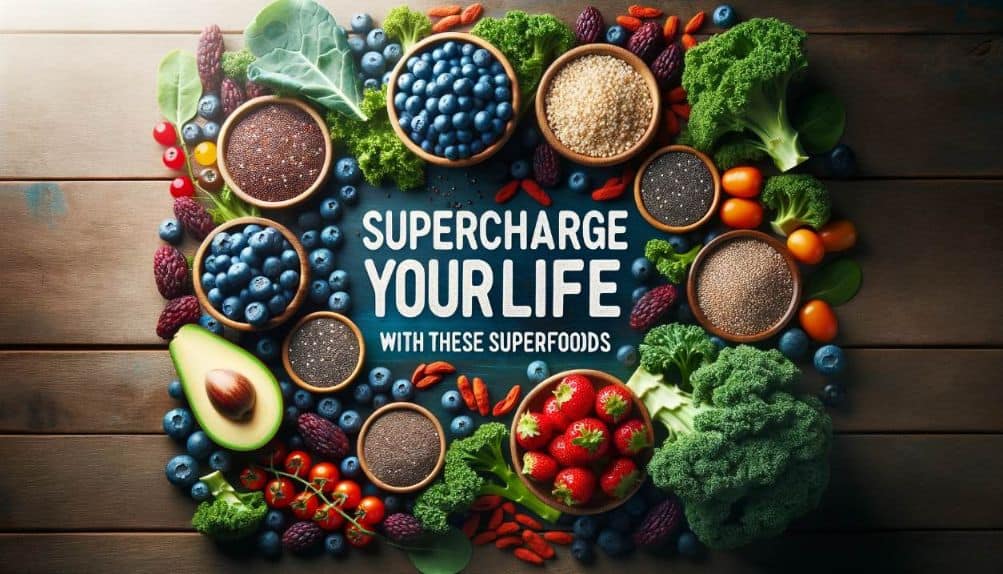Superfoods can supercharge your life. They can improve your energy levels, boost your immune system, reduce your risk of heart disease and cancer, and even help you lose weight.
But what are they? And how do they work? Read on to learn more about the top 10 superfoods that will make a difference in your health and well-being.
Key Takeaways
- Fuel your weight loss journey with nutrient-rich, low-calorie foods.
- Prioritize health and sustainability over fad diets or miracle foods.
- Choose whole, unprocessed foods like fruits, veggies, lean proteins, and healthy fats.
- Avoid overprocessed foods high in fat and lacking in dietary fiber.
- Stay hydrated by drinking water with meals to support portion control and digestion.
- Understand the role of nutrition in achieving and maintaining weight goals.
- Mindfully choose foods that are nutrient-dense and promote satiety.
- Watch out for pitfalls in foods that can hinder weight loss efforts.
- Combine nutrition with fitness activities for enhanced results.
- Debunk myths and make informed choices about weight loss foods.
- Embrace a holistic approach to weight management that includes mental well-being and lifestyle choices.

Dive Deeper into Superfoods: Exploring Their Benefits
While the existing article provides a solid overview of superfoods, let’s delve deeper and explore the specific benefits associated with some of the highlighted items:
Goji Berries
Gojis have been used for thousands of years by Chinese people as an herbal remedy. The berries contain high amounts of antioxidants called polyphenols, which protect against free radicals. Free radicals damage cells within our body, causing them to age prematurely.
Antioxidants also prevent cell mutations from occurring, so we don’t get diseases like cancer or diabetes. Studies show that goji berry extract has anti-cancer properties and may be able to slow down tumor growth. This effect could be due to its ability to block certain enzymes involved in DNA synthesis. This means it stops new cells from being created and slows down how cancers grow.
In addition, studies suggest that goji berries may increase insulin sensitivity, meaning blood sugar levels stay normal. Insulin resistance occurs when insufficient insulin is available to transport glucose into muscle tissue where it’s needed. As a result, excess glucose builds up in the bloodstream, leading to type 2 diabetes. Research suggests that consuming goji berries regularly might help lower the chances of developing type 2 diabetes.
Acai Berry
Acai berries come from acacia trees native to Brazil. These small red fruits contain vitamins A, C, E, B6, folic acid, iron, calcium, magnesium, potassium, zinc, copper, manganese, phosphorus, and fiber.
They’re rich in anthocyanins – powerful antioxidant compounds found naturally in blueberries, blackcurrants, and raspberries. Anthocyanin extracts have shown promise in helping fight inflammation linked to arthritis and asthma.
One study showed that taking 500mg daily reduced joint pain associated with osteoarthritis. Another trial suggested that eating 100g of acai berries daily lowered cholesterol levels by 5%. Other research shows that regular consumption of acai berries helps maintain healthy skin, hair, and nails.
Almonds
Almonds are one of nature’s most nutritious foods. Rich in protein, vitamin D, folate, monounsaturated fats, and minerals like selenium, almonds provide essential building blocks for strong bones and teeth. Eating just two handfuls of raw unsalted almonds each week provides all the recommended dietary allowance for adults.
According to experts, almond oil contains some of the highest omega-3 fatty acid concentrations compared to other food sources. Omega 3 fats are vital because they are essential in maintaining good cardiovascular function, boosting brain power, and protecting eyesight. Raw almonds are also excellent sources of fiber, making them beneficial for digestive health.
Avocado
Avocados are delicious tropical fruit grown mainly in Mexico, Central America, and South Africa. High in fat but low in calories, avocados contain many heart-healthy monounsaturated fats, vitamins K & C, folate, biotin, and plenty of fiber.
Add avocado slices to your salads for added creaminess; mash them on sandwiches instead of bread for extra crunch; use them in guacamole recipes, or enjoy them sliced over fish dishes. Add diced avocado to soups and stews for more flavor if you can find ripe ones.
Unlocking the Power of Plant-Based Superfoods
Many plant-based foods qualify as superfoods, offering a wealth of beneficial nutrients and promoting overall well-being. Consider incorporating these into your diet:
Beans
Beans are full of plant-based proteins, complex carbohydrates, and fiber. Packed with soluble and insoluble fibers, beans keep your digestion moving smoothly, filling you up without weighing you down.
Fiber also keeps your gut bacteria happy, promoting intestinal wellness and keeping bloating away. Try different beans: adzuki, cannellini, chickpeas, lentils, navy, pinto, soybeans, white kidney, and yellow split peas. And remember to soak dried beans before cooking them to ensure they cook evenly.
Blueberry
Blueberries are bursting with disease-fighting antioxidants and phytochemicals. Phytochemicals are chemical substances produced by plants that act as natural pesticides, deterring insects from feeding on their leaves. When eaten, these chemicals enter the human system through the stomach walls and travel through the body via the lymphatic system.
This means consuming large amounts of fresh blueberries is an easy way to get high doses of anti-oxidants into our bodies. Antioxidant intake effectively reduces risk factors for many diseases, especially cancer. In fact, according to researchers, “blueberries may be able to prevent certain types of cancers due to their ability to block tumor growth.” The USDA recommends men eat about 2 cups of fresh blueberries every week. Women should aim for 1 cup.
Broccoli
Broccoli is not only tasty, but it’s also extremely versatile! It works well sautéed, steamed, stir-fried, roasted, broiled, grilled, baked…the list goes on. Broccoli is chockfull of Vitamin C, which boosts immunity and protects against infections. It also contains sulforaphane, a compound that gives broccoli its cancer-fighting properties.
Sulforaphane activates detoxifying enzymes called glutathione S transferases, which help neutralize carcinogens within cells. Studies show that people who regularly consume cruciferous vegetables containing sulforaphane tend to develop fewer tumors than others. Researchers believe this is why Asians typically live longer than Americans despite having diets higher in meat and saturated fat.
Eaten raw broccoli is even better for you since it retains more anti-cancer benefits. A recent study found that eating just one serving of cooked broccoli daily reduces breast cancer risk by 30 percent. That’s enough reason to add some broccoli to your diet today.
Brown Rice
Brown rice contains magnesium, manganese, vitamin B1, iron, zinc, and phosphorus. These minerals are important in maintaining healthy bones, teeth, and blood vessels. They’re essential for energy production and metabolism, helping us absorb calcium and other vital nutrients.
Brown rice is a whole grain because it maintains most of its bran layer after processing. Whole grains have all three parts of the wheat kernel intact, including the germ, endosperm, and bran layers. Eating brown rice helps lower cholesterol levels and reduce risks of diabetes, cardiovascular problems, and stroke.
One medium-sized bowl of uncooked brown rice provides approximately 50% of the recommended daily allowance of potassium, 20% of protein, 15% of dietary fiber, 10% of niacin, 8% of thiamine, 7% of riboflavin, 6% of pantothenic acid, 5% of copper, 4% of selenium, 3% of phosphorous, 2% of iodine, 2% of zinc, 2% of magnesium, and 0.3% of sodium.
Chia Seeds
Chia seeds are tiny blackish-brown seeds that grow inside cactus flowers. They contain omega-3 fatty acids, fiber, vitamins, minerals, amino acids, antioxidants, proteins, carbohydrates, chlorophyll, tannins, saponins, flavonoids, glycosides, mucilage, polysaccharide, sterols, alkaloids, carotenes, coumarins, phenolic compounds, triterpenes, lignans, terpene alcohols, volatile oils, and fats.
Chia seeds can easily replace eggs or flaxseed meals in baking recipes. They make great additions to smoothies, salads, soups, oatmeal, yogurt, dips, granola bars, muffins, pancakes, waffles, bread, cookies, cakes, pies, pasta dishes, sauces, dressings, and much more. You’ll find them sold ground, cracked, whole, sprouted, frozen, dried, canned, and bottled. Look for organic varieties if possible.
Flaxseeds
Flaxseeds are rich sources of plant-based omega-3 fatty acids, fiber, vitamins, minerals, and antioxidants. Omega-3 fatty acids benefit heart health, brain function, skin care, joint support, and immune function. Fiber keeps you full between meals, so you don’t overeat.
Flaxseeds provide 11 grams per tablespoon. You can use the oil from flaxseeds as an additive in food products such as salad dressing, mayonnaise, margarine, and ice cream. Flaxseeds are often added to cereals, crackers, bread, pasta, snacks, beverages, desserts, spreads, condiments, toppings, nut butter, yogurts, cheeses, meats, fish, poultry, veggie burgers, pizza crusts, etc.
Hemp Seeds
Hemp seeds are high in protein, complete protein, a good source of unsaturated fats, low in calories, and very nutritious. They are loaded with many valuable phytochemicals, especially gamma-linolenic acid. GLA is an omega-6 fatty acid that reduces inflammation, promotes cell growth, and protects the body’s tissues.
In addition to being anti-inflammatory, GLA promotes tissue repair and healing. Research shows that hemp seed oil supports normal cellular functions, improves digestion, relieves pain, eases arthritis symptoms, enhances mental clarity, increases stamina, lowers stress hormones, fights depression, prevents premature aging, and strengthens hair, nails, and muscles.
Kale/Collard Greens
Kale and collards are two superfoods that combine beautifully into one dish. Both kale and collards are members of the cabbage family and share similar nutritional profiles. Collards are slightly sweeter than kale and usually cook longer, while kale tastes milder and cooks faster. Either way, both greens offer plenty of nutrition.
Kale contains lots of beta-carotene, which converts to Vitamin A in your system. It also offers folate, vitamin C, E, calcium, iron, magnesium, potassium, phosphorous, sulfur, zinc, and fiber.
Collard leaves are higher in vitamin K, folic acid, vitamin C, vitamin A, vitamin B2, vitamin B5, vitamin B6, vitamin B7, vitamin B8, vitamin B9, vitamin B12, biotin, choline, chromium, copper, iron, molybdenum, nickel, phosphorus, potassium, silicon, sulfur, vanadium, vitamin D, vitamin E, vitamin F, vitamin G, vitamin H, vitamin J, vitamin P, vitamin Q, vitamin R, vitamin S, vitamin T, vitamin U, vitamin V, vitamin W, vitamin X, vitamin Y, vitamin Z, and zink.
Latest Science-Backed Data

1. Superfoods for Type 2 Diabetes
- Publication Date: June 21, 2023
- Source: Medicina
- Summary: This study emphasizes the role of superfoods like berries, fermented dairy products, whole cereals/grains, and nuts in managing Type 2 Diabetes Mellitus (T2DM). These foods, rich in polyphenols and other essential nutrients, have shown potential in reducing glycaemic levels in T2DM patients.
2. Millet: A Traditional Superfood
- Publication Date: May 6, 2023
- Source: Future of Food: Journal on Food, Agriculture and Society
- Summary: Millet, a traditional Indian food, is now recognized as a superfood due to its high nutritional value. Despite being rich in essential nutrients, it is still underutilized. The study evaluates millet awareness and consumption behavior among urban women in South India.
3. Vegetarian and Mediterranean Diets as Superfoods
- Publication Date: November 16, 2022
- Source: Polish Journal of Food and Nutrition Sciences
- Summary: Both vegetarian and Mediterranean diets are highlighted for their health benefits, including improved lipid profiles reduced risks of cardiovascular diseases, cancer, and diabetes. These diets are rich in essential nutrients and promote overall health and well-being.
4. Pseudocereals: A New Age Superfood
- Publication Date: October 10, 2022
- Source: Current Nutrition & Food Science
- Summary: Pseudocereals like amaranth, quinoa, and buckwheat are emphasized for their high nutritional and phytochemical compositions. These gluten-free grains are rich in starch, fiber, proteins, minerals, vitamins, and offer numerous health benefits, including lowering the risk of chronic diseases such as diabetes and cancer.
FAQs
What are superfoods? Superfoods are nutrient-rich foods with health benefits, such as kale, blueberries, and salmon.
How can superfoods improve my health? Superfoods provide essential nutrients that support overall health and may help prevent certain diseases.
Which superfoods are rich in antioxidants? Berries, dark chocolate, and spinach are superfoods packed with antioxidants.
Can superfoods help with weight loss? While superfoods alone won’t guarantee weight loss, they can be part of a balanced diet that supports a healthy weight.
Are superfoods suitable for everyone? Superfoods can be included in most diets, but it’s essential to consider individual dietary restrictions and allergies.
Supercharge Your Life With These Superfoods: Unlock the Power of Delicious Nutrition!

Ready to supercharge your life with the ultimate culinary adventure? Say goodbye to boring diets and hello to a world of delicious weight loss secrets. Discover the top superfoods to help you shed those extra pounds while tantalizing your taste buds!
Embracing a superfood-filled lifestyle unlocks a world of deliciousness and health benefits. Remember:
- Focus on whole, unprocessed foods: Opt for fruits, vegetables, lean proteins, and healthy fats.
- Prioritize sustainability: Choose locally grown, seasonal produce whenever possible.
- Combine superfoods with other healthy habits: Regular exercise and adequate sleep are essential for optimal health.
- Make informed choices: Educate yourself on superfoods and their benefits to personalize your diet.
You can enjoy a vibrant and healthy life by incorporating superfoods into your daily routine. Start your superfood journey today and experience the difference!
As a veteran fitness technology innovator and the founder of GearUpToFit.com, Alex Papaioannou stands at the intersection of health science and artificial intelligence. With over a decade of specialized experience in digital wellness solutions, he’s transforming how people approach their fitness journey through data-driven methodologies.